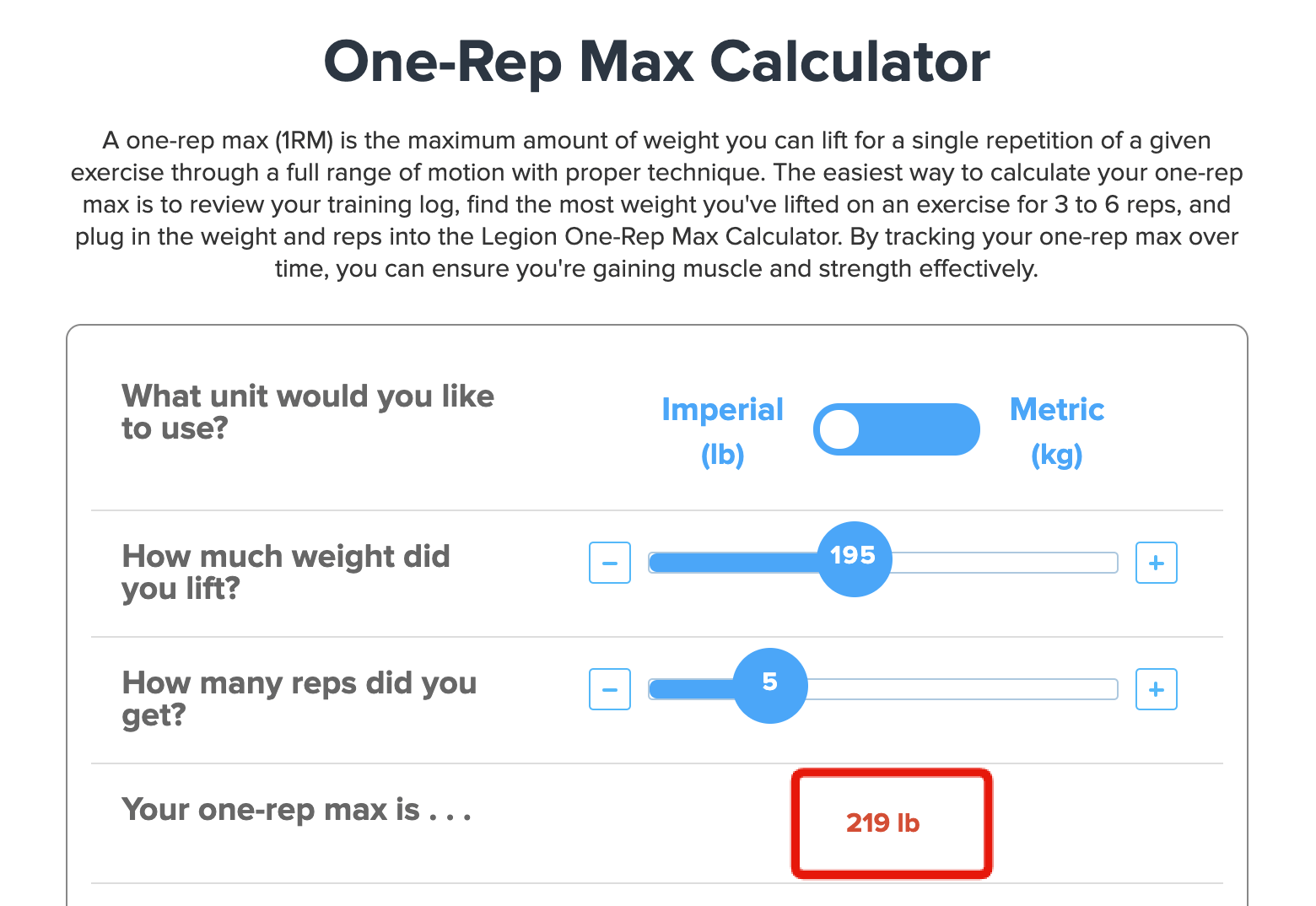Progress comes easy when you first start lifting weights. You show up and get stronger almost without even trying.
As you get stronger, though, smooth sailing turns into choppy waters. Progress stops being linear. Some weeks you’re a little weaker, other weeks you’re a little stronger, and it becomes harder to tell if you’re really getting stronger or not over time.
At this point, the best way to measure your progress is to start tracking your one-rep max.
A one-rep max is the maximum amount of weight you can lift for a single repetition of a given exercise through a full range of motion with proper technique.
There’s a problem with actually testing your one-rep max, though:
True one-rep max tests are time-consuming, risky, and exhausting, and can significantly disrupt your normal workout routine.
Thus, a better alternative is to estimate your one-rep max using what’s known as a rep-max test.
While not quite as precise as a real one-rep max test, rep-max testing is far less arduous and still accurate enough to track your progress over time.
Let’s get started.
Why You Should Track Your One-Rep Max

If your one-rep max has stopped going up, this is a red flag that you need to change your training, diet, or lifestyle habits to kickstart progress again.
It’s very easy to fall into a pernicious rut—what I like to call performance purgatory—where you think you’re getting stronger but are really spinning your wheels. This usually happens after your newbie gains are gone and new PRs are becoming increasingly elusive.
Here’s how this usually works:
You add weight or reps to an exercise for 4 or 5 weeks, working your way up to, say, deadlifting 315 pounds for 5 reps—progress! Then, you have a few workouts that feel “off.” You drop the weight down to 275, and spend the next few weeks retracing your steps back to 315—more progress!
Then your workouts get hard again, you drop the weight again, and repeat ad infinitum. In other words, brief bouts of progress followed by regress obscure the fact that you aren’t really getting stronger over time.
It’s the training equivalent of yo-yo dieting.
Tracking your one-rep max knocks the scales from your eyes and helps you see whether you’re really making progress or not. And if not, knowing your one-rep max is also one of the first steps to correcting the problem.
What does that mean, exactly?
Assuming you’re eating properly and getting enough sleep, the most common reason people plateau is they’re either not training hard enough or aren’t recovering effectively from their workouts.
Knowing your one-rep max helps you adjust your training weights so that you’re training hard enough to make progress while allowing the right amount of recovery to get stronger over time. Instead of picking a weight based on how you feel—a subjective and fickle number—you can pick weights based on a percentage of your one-rep max—an objective and reliable metric.
Read: Should You Periodize Your Workouts? The Definitive Answer, According to 26 Studies
Why You Should Do Rep-Max Tests
A true one-rep max test involves lifting the heaviest weight you can for a single repetition with proper technique—usually taking the rep just shy of muscular failure.
While this is the only 100%-accurate way to know how much weight you can lift for a single rep, it’s also time-consuming, risky, and exhausting:
- To test your true max, you first need to train with lighter weights and lower volumes for several days to a week beforehand to make sure you’re rested.
- You then have to push yourself very close to absolute muscular failure, which is where your technique is most likely to break down and precipitate an injury.
- Finally, a true one-rep max test is going to leave you feeling drained for at least a few days, during which you’ll need to use lighter weights or lower volumes.
This is where rep-max testing enters the picture—it’s a safer, more enjoyable, and more time-efficient way to estimate your one-rep max. Although not quite as accurate as a true one-rep max test, a rep-max test is close enough to accurately track your progress and make informed decisions about your training.
Rep-Max Testing Explained
A rep-max test works the same way as a one-rep max test, except you lift a slightly lighter weight for as many reps as you can before your technique starts to break down. Typically, a rep-max test involves lifting a weight for 2 to 6 reps, though it’s always more than 1 and can be as high as 10 or 12.
A rep-max test is also sometimes referred to as an AMRAP test, which stands for As Many Reps As Possible.
The reason you want to shoot for 2 to 6 reps in your rep-max tests is that this range strikes the best balance between accuracy and difficulty. Lower rep sets (~2 to 6) are more accurate in predicting your one-rep max than higher-rep sets (6+), but still not as draining as a true one-rep max.
After performing a rep-max test, you use an equation to predict your one-rep max based on how many reps you got with the weight. Or, you can plug your numbers into a one-rep max calculator that does all of the math for you (what I recommend).
For example, let’s say you want to do a bench press rep-max test. In a recent workout, you did 6 reps with 185 pounds.
Since you want to get 2 to 6 reps in your rep-max test, you bump up the weight to 195 pounds to ensure you stay in this range.
Then, after warming up, you do as many reps as you can with 195 pounds until your form starts to slip. You get 5 reps—hooray!
Then, you’d open the Legion One-Rep Max Calculator, enter your numbers, and review the results:

According to your rep-max test, your predicted bench press one-rep max is 219 pounds.
How to Do a Rep-Max Test
Follow this simple eight-step process to do a rep-max test and estimate your one-rep max:
- Decide what exercise you’d like to estimate your one-rep max for, and move it to the beginning of your workout. For example, if you normally incline bench press before flat bench press, and you want to test your flat bench press one-rep max, switch around your exercise order so you flat bench press first.
- Do a thorough warm-up.
- Once you’re finished with your warm-up, rest at least 3 to 4 minutes.
- Load the bar (or pick up dumbbells) with a weight that you think you can lift for 2 to 6 repetitions.
- Set up, brace properly, and do as many reps as you can before your technique starts to falter or your reach muscular failure.
- If you got 2 to 6 reps, write down how much weight you used and how many reps you got. This is your “rep max.”
- If you got 7 or more reps, add 5 to 10 pounds to the barbell or dumbbells, rest at least 3 to 5 minutes, and try again. You might be a little tired, but you should still have enough gas left in the tank to beat your numbers from the first set.
- After completing your rep-max test, finish your regular workout.
Then, with new rep-max results in hand, plug your numbers into the Legion One-Rep Max Calculator to estimate your one-rep max!
5 Tips for Acing a Rep-Max Test

Although a rep-max test isn’t as grueling as a one-rep max test, it’s no picnic.
Use these five strategies to prepare properly.
1. Get plenty of sleep beforehand.
Research shows that sleeping even an hour or two more than usual can significantly increase your athletic performance.
Although the ideal amount of sleep differs for everyone, try to get to bed an hour or so earlier than usual in the days leading up to your rep-max test. At the very least, let yourself wake up without an alarm on the day of your test.
2. Reduce your training volume the week leading up to your test.
Strategically reducing your training volume (how many sets you do in a given workout and throughout the week) is known as tapering, and it’s one of the most effective ways to goose your strength and endurance.
A good protocol for tapering before a rep-max test is to cut your reps and sets in half during the week leading up to your test, while using your normal training weights. For example, if you normally do 4 sets of 6 reps of bench press with 185 pounds, you’d want to do 2 sets of 3 reps with 185 pounds.
In weightlifting circles, this is often referred to as deloading, and you can learn more about it in this article:
3. Recruit a spotter.
Spotting refers to the practice of watching another weightlifter while they do a set to help catch the weight if they start to fail.
Not only does this make rep-max testing safer, it also helps you lift more weight. When you know someone has your back as you approach muscular failure, you’re willing to dig deeper than if you were on your own.
The key to working with a spotter is communication. Tell them how many reps you’re going for and when they should or shouldn’t touch the bar (or dumbbells). As a rule of thumb, a spotter should never touch the bar unless it completely stops or starts going downward against your will.
4. Fire yourself up.
Or as Theodore Roosevelt would say, kindle your barbarian virtues.
Play your favorite workout music.
Imagine yourself crushing the set with energy to spare.
Read some inspirational quotes.
Take a moment to shed your civilized inclinations and embrace that savage streak buried in your DNA. You know it’s there.
5. Drink a pre-workout supplement 30 to 60 minutes before your test.
There’s no shame in imbibing some liquid courage.
The right pre-workout supplement can increase energy levels, improve mood, sharpen mental focus, reduce fatigue, and boost your strength and endurance.
And if you want a 100% natural pre-workout drink with clinically effective dosages of scientifically proven ingredients like caffeine, beta-alanine, betaine, and more, try Pulse.
More of a coffee person, you say? Then stack your jitter juice with caffeine-free Pulse, which contains the same performance-boosting ingredients, sans caffeine.
Scientific References +
- Mah, C. D., Mah, K. E., Kezirian, E. J., & Dement, W. C. (2011). The effects of sleep extension on the athletic performance of collegiate basketball players. Sleep, 34(7), 942–950. https://doi.org/10.5665/SLEEP.1132
- Mayhew, J. L., Johnson, B. D., Lamonte, M. J., Lauber, D., & Kemmler, W. (2008). Accuracy of prediction equations for determining one repetition maximum bench press in women before and after resistance training. Journal of Strength and Conditioning Research, 22(5), 1570–1577. https://doi.org/10.1519/JSC.0b013e31817b02ad
- Reynolds, J. M., Gordon, T. J., & Robergs, R. A. (2006). Prediction of one repetition maximum strength from multiple repetition maximum testing and anthropometry. Journal of Strength and Conditioning Research, 20(3), 584–592. https://doi.org/10.1519/R-15304.1
- Dohoney Paula, Chromiak Joseph A, Lemire Derek, & Abadie Ben R. (n.d.). Prediction of one repetition maximum (1-RM) strength from a 4-6 RM and a 7-10 RM submaximal strength test in healthy young adult males. Retrieved March 7, 2021, from https://www.researchgate.net/publication/228503989_Prediction_of_one_repetition_maximum_1-RM_strength_from_a_4-6_RM_and_a_7-10_RM_submaximal_strength_test_in_healthy_young_adult_males










